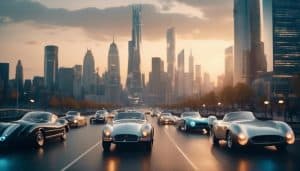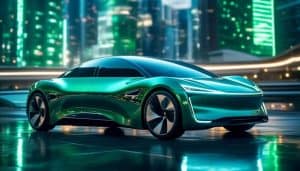
The car, or automobile, has undergone an extraordinary evolution since the late 19th century, transitioning from rudimentary carriages powered by steam engines to the sophisticated, computerized vehicles of today. The history of the automobile is a testament to human ingenuity, serving as a mirror to the technological and cultural shifts of society throughout the ages.
Over time, the industry has faced numerous challenges and opportunities, from the oil crises of the 1970s to the recent surge in environmental consciousness driving the move towards electric vehicles (EVs) . As manufacturers continue to innovate, incorporating advanced materials and exploring alternative powertrains, the industry stands at a critical juncture.
With the advent of autonomous driving technologies and the potential reshaping of urban landscapes, the future of automobiles promises to be as dynamic and transformative as its past. This examination aims to present a balanced overview, tracing the lineage of the automobile from its early inception to its current state, and considering the implications of emerging trends as we steer towards an uncertain yet intriguing horizon.
Identities
- Glossary: Car
- Wikipedia: Car
- Wiktionary: Car
- DBPedia: Car
- ProductOntology: Car
- Wikidata: Q1420
- KnowledgePanel: /m/0k4j
Key Takeaways
- The invention and evolution of cars have played a significant role in transportation, with the modern car being invented in 1886 by Carl Benz.
- Cars have undergone technological advancements, including the addition of features like rear-reversing cameras, air conditioning, and navigation systems.
- The transition from fossil fuel-powered cars to electric cars is an important aspect of mitigating climate change.
- The use of cars brings both individual costs (acquiring the vehicle, repairs, fuel, and insurance) and societal costs (road maintenance, congestion, pollution, and public health issues), but also provides personal benefits (on-demand transportation and convenience) and societal benefits (economic benefits and revenue generation from the automotive industry).
The Dawn of Automobiles

The dawn of the automobile era was marked by the invention of the first steam-powered road vehicle by Nicolas-Joseph Cugnot in 1769, paving the way for a transformative mode of transportation. Early automotive pioneers like Cugnot, and later Karl Benz and Gottlieb Daimler, catalyzed profound shifts in the transportation industry.
These innovations disrupted the status quo of horse-drawn conveyances and set in motion a new era of mobility. The evolution of automobiles from luxurious novelties to mass-produced essentials underscored their impact on the transportation industry, revolutionizing travel, commerce, and urban planning.
These advancements ushered in unprecedented changes in society, reshaping landscapes and economies, and highlighting the automobile’s role as a cornerstone of modern life.
Advancements in Car Technology
Building on the legacy of early automotive pioneers, contemporary car technology has experienced a surge in innovation. This includes the integration of artificial intelligence and the development of electrification and autonomous driving systems.
Autonomous vehicles are at the forefront of this technological revolution. Numerous companies are investing heavily in the research and development of self-driving cars. These vehicles promise to redefine the principles of road safety and traffic efficiency.
Meanwhile, the concept of sustainable mobility is driving the industry towards electric vehicles (EVs). Advancements in battery technology and energy recovery systems are improving the range and performance of EVs.
These technological strides are reshaping the automotive landscape. They are contributing to a future where transportation is cleaner, smarter, and more efficient.
Socioeconomic Impact of Cars
Automobiles have profoundly shaped the socioeconomic landscape, influencing everything from urban planning to the dynamics of global trade. The proliferation of cars has spurred the development of vast urban infrastructure, leading to the expansion of cities and the creation of suburbs. However, this growth has also brought environmental implications, including pollution and the transformation of natural landscapes.
| Aspect | Positive Impact | Negative Consequence |
|---|---|---|
| Urban Development | Facilitated suburban expansion | Led to urban sprawl |
| Economy | Boosted global trade and jobs | Contributed to economic divides |
| Environment | Improved mobility | Increased pollution and resource depletion |
This table encapsulates the dichotomy of the automobile’s influence on society, reflecting both its indispensable role in modern life and the challenges it presents.
Automobile Manufacturing Evolution

While the socioeconomic impact of cars has led to significant urban and economic development, it is equally important to examine how the manufacturing of these vehicles has evolved to meet the changing demands and technological advancements.
The evolution of automobile manufacturing has been transformative, with several key milestones:
- Introduction of the moving assembly line by Ford in 1913, revolutionizing production efficiency.
- Implementation of robotics and automation technologies in the 1960s, enhancing precision and consistency.
- Adoption of lean manufacturing principles in the 1990s, optimizing resource utilization and waste reduction.
- Integration of Industry 4.0 practices in the 21st century, further digitizing and interconnecting production processes.
These advancements have had a profound impact on employment, both creating and displacing jobs, necessitating continuous workforce adaptation to new manufacturing technologies.
Modern Fuel and Propulsion
How have modern fuel and propulsion technologies reshaped the landscape of automotive design and functionality in recent years? The integration of alternative power sources has been pivotal in driving sustainability in transportation. Innovations in battery technology, electric motors, and fuel cell development have led to a proliferation of electric and hybrid vehicles. These advancements offer reduced emissions and the promise of a less oil-dependent future. The automotive industry’s commitment to sustainability is also evident in the increased use of renewable materials and energy-efficient manufacturing processes.
| Propulsion Type | Characteristics |
|---|---|
| Internal Combustion | Dominant, improving efficiency |
| Battery Electric | Zero emissions, rising adoption |
| Hybrid | Efficiency, lower emissions |
| Plug-In Hybrid | Electric + ICE flexibility |
| Hydrogen Fuel Cell | High energy, water byproduct |
This table encapsulates the diversity and innovation within current automotive propulsion systems, reflecting a market increasingly geared towards environmental responsibility and energy diversification.
Trends in User Interface

As modern fuel and propulsion technologies continue to evolve, significant attention is also being given to enhancing the user interface in vehicles to improve driver interaction and safety. The integration of advanced user interfaces in automobiles reflects a shift towards creating more intuitive and safer ways for drivers to interact with their vehicles’ systems.
Here are the current trends:
- Voice Recognition: Implementation of sophisticated voice command systems allows drivers to control various functions without physical contact, reducing distraction.
- Touchscreen Controls: Increasing prevalence of capacitive touchscreens offers a sleek, button-free dashboard design, enabling more dynamic interaction with in-car features.
- Haptic Feedback: Integration of haptic technology provides tactile responses to touchscreen inputs, aiding in user confirmation without visual confirmation.
- Customizable Interfaces: Development of adaptive UIs that can be personalized to individual preferences, enhancing the driving experience and accessibility.
Safety Measures and Regulations
With the advancement of automotive technology, stringent safety measures and regulations have been implemented to protect vehicle occupants and pedestrians, aiming to reduce the number of traffic collisions and fatalities. Crash testing standards, such as those enforced by the Euro NCAP and the Insurance Institute for Highway Safety (IIHS), provide consumers with safety ratings that influence vehicle design and manufacturing. These standards are constantly evolving to reflect the latest safety technologies and real-world accident data.
Modern vehicles increasingly incorporate advanced driver assistance systems (ADAS) that mitigate human error and enhance safety. Features like automatic emergency braking, lane-keeping assist, and adaptive cruise control represent a significant leap forward in reducing road accidents. Regulatory bodies worldwide are mandating these technologies to ensure a higher baseline of vehicle safety.
Future of Automotive Innovation

Building upon established safety measures and regulations, the automotive industry is now poised to embrace a new era of technological innovation that promises to redefine vehicular mobility. Key advancements include:
- The development of autonomous vehicles, leveraging sophisticated sensors and AI to navigate without human intervention, promising to enhance road safety and traffic efficiency.
- Integration of electric powertrains in pursuit of sustainable transportation, reducing reliance on fossil fuels and lowering emissions.
- Advanced materials and manufacturing techniques that improve vehicle performance while minimizing environmental impact.
- Connectivity enhancements that facilitate vehicle-to-everything (V2X) communication, enabling real-time data exchange and smarter traffic management.
These innovations are grounded in rigorous research and empirical data, illustrating the industry’s commitment to a future where mobility is both advanced and responsible.
